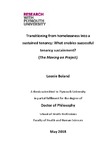Transitioning from homelessness into a sustained tenancy: What enables successful tenancy sustainment? (The Moving on Project)
| dc.contributor.supervisor | Bannigan, Katrina | |
| dc.contributor.author | Boland, Leonie | |
| dc.contributor.other | Faculty of Health | en_US |
| dc.date.accessioned | 2018-06-14T12:07:07Z | |
| dc.date.issued | 2018 | |
| dc.identifier | 10512025 | en_US |
| dc.identifier.uri | http://hdl.handle.net/10026.1/11660 | |
| dc.description.abstract |
For individuals with multiple and complex needs, leaving homelessness is recognised as a dynamic and complex process. Furthermore, despite the provision of supports, tenancies may not be maintained and individuals return to using homelessness services. Tenancy sustainment—the maintenance of a tenancy to avoid a premature end of tenure—is fundamental to the resolution and prevention of homelessness. There is a paucity of research about the occupations of individuals as they establish and maintain tenancies. This thesis aimed to understand the transition process from homelessness, and tenancy sustainment, from an occupational perspective, to inform a potential occupational therapy intervention. Underpinned by the Medical Research Council (2008) framework for the development and evaluation of complex interventions, a systematic review and a constructivist grounded theory study were conducted in a convergent mixed method study design. The systematic review synthesised the evidence on tenancy sustainment following homelessness from a broad range of studies. It presented positive determinants of tenancy sustainment at individual, interpersonal, community and structural levels. The constructivist grounded theory study was conducted with people who were experiencing or had experienced multiple exclusion homelessness as well as staff in homelessness services. Individuals (n=35) were purposively sampled and interviews using reflexive photography were conducted. A substantive theory about the core process of tenancy sustainment was conceptualised as ‘Making a Home’. This was enacted through identified occupational strategies of ‘putting your stamp on it’, ‘seeing a new self’ and ‘living the life’. Tenancy sustainment was experienced as ‘feeling at home’, which had two sub-categories: ‘belonging’, which was a sense of connection to place, as well as, ‘having connections’ to other people. The key mediating factor to enable tenancy sustainment was taking control over activities. The findings were synthesised to propose a framework of factors that influence successful tenancy sustainment. Engagement in occupations, as individuals established and sustained tenancies, provided a sense of well-being, a sense of control as well as social connections. This indicates the value, to all who support individuals leave homelessness, of providing opportunities and supporting tenants to engage in personally meaningful occupations. In addition, this thesis provides a foundation for the development of an occupational therapy intervention for tenancy sustainment following homelessness. | en_US |
| dc.description.sponsorship | Catherine Mounter Legacy, Plymouth University | en_US |
| dc.language.iso | en | |
| dc.publisher | University of Plymouth | |
| dc.subject | Tenancy sustainment | en_US |
| dc.subject | Occupational Therapy | en_US |
| dc.subject | Occupational Science | en_US |
| dc.subject | Transition | en_US |
| dc.subject | Tenancy | en_US |
| dc.subject | Multiple exclusion homelessness | en_US |
| dc.subject | Homeless persons | en_US |
| dc.subject.classification | PhD | en_US |
| dc.title | Transitioning from homelessness into a sustained tenancy: What enables successful tenancy sustainment? (The Moving on Project) | en_US |
| dc.type | Thesis | |
| plymouth.version | publishable | en_US |
| dc.identifier.doi | http://dx.doi.org/10.24382/722 | |
| dc.rights.embargodate | 2019-06-14T00:00:00Z | |
| dc.rights.embargoperiod | 12 months | en_US |
| dc.type.qualification | Doctorate | en_US |
| rioxxterms.version | NA | |
| plymouth.orcid.id | http://orcid.org/0000-0002-1476-324X | en_US |
Files in this item
This item appears in the following Collection(s)
-
01 Research Theses Main Collection
Research Theses Main


